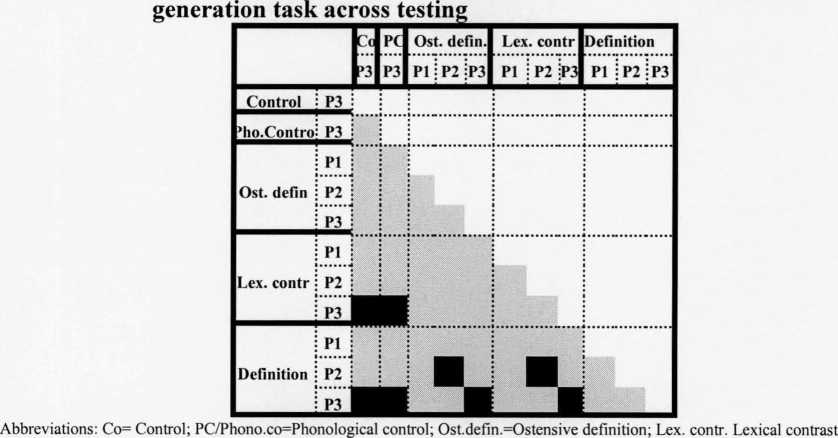(Kruskall-Wallis-I Way Anova:X2 =26.7, df = 4, p<.0000). Particularly, the Definition group
provided significantly more stories than the Ostensive definition (Wilcoxon,: Z=2.8, p<.005)
and the Lexical contrast group (Wilcoxon: Z=3.6, p<.0005) during post test 2. During post
test 3, the Lexical contrast group provided significantly more stories than the Control
(Wilcoxon: Z = 2.1, p<.05) and Phonological Control groups (Wilcoxon: Z = 2.04, p<.05).
In addition, the Definition group performed significantly better than the two Control and
Experimental groups (Z=3.8, p<.0005; Z=3.8, p<.0005; Z=3.5, p<.0005; Z=2.2, p<.05). No
significant differences were found between the two Control groups and the Ostensive
definition group in any of the post tests. Diagram 7.10 presents the significant differences
between the groups
Diagram 7.10 Significant group differences in the provision of stories in the story

Does children ,s provision of stories increase with increased exposure to the lexical items?
All the children provided more stories over time. Particularly, they provided significantly
more stories during post test 3 than during post test 1 (Wilcoxon: Z=3.3, p<.005). The
analysis was repeated separately for each group. The same pattern was found for the Lexical
contrast group (Wilcoxon: Z=2.1, p<.05) and the Definition groups (Wilcoxon: Z=3.2,
p<.005). In addition, the Definition group provided significantly more stories during post test
2 than post test 1 (Wilcoxon: Z=2.3, p<.05).
266
More intriguing information
1. A production model and maintenance planning model for the process industry2. Om Økonomi, matematik og videnskabelighed - et bud på provokation
3. The name is absent
4. The geography of collaborative knowledge production: entropy techniques and results for the European Union
5. EU Preferential Partners in Search of New Policy Strategies for Agriculture: The Case of Citrus Sector in Trinidad and Tobago
6. The name is absent
7. The role of statin drugs in combating cardiovascular diseases
8. Plasmid-Encoded Multidrug Resistance of Salmonella typhi and some Enteric Bacteria in and around Kolkata, India: A Preliminary Study
9. The name is absent
10. The name is absent